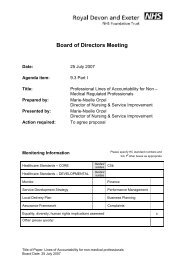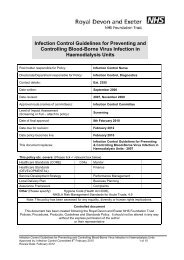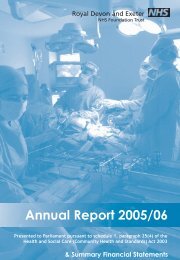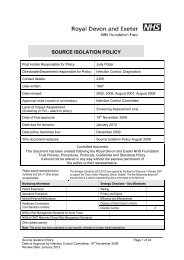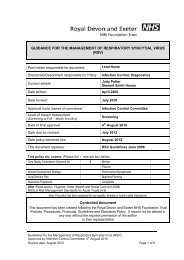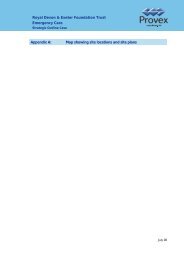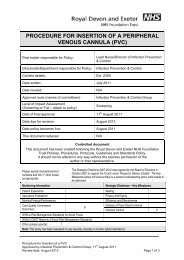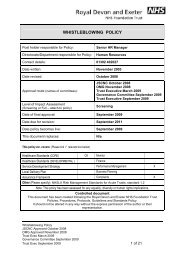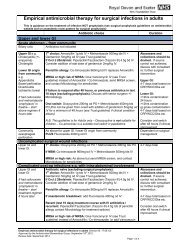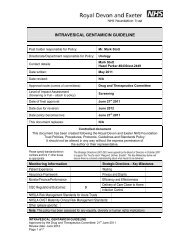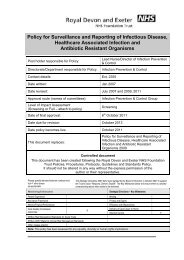Annual Report and Accounts 2012/13 - Royal Devon & Exeter Hospital
Annual Report and Accounts 2012/13 - Royal Devon & Exeter Hospital
Annual Report and Accounts 2012/13 - Royal Devon & Exeter Hospital
You also want an ePaper? Increase the reach of your titles
YUMPU automatically turns print PDFs into web optimized ePapers that Google loves.
12 2. Progress on our<br />
<strong>2012</strong>/<strong>13</strong> Priorities<br />
<strong>Royal</strong> <strong>Devon</strong> <strong>and</strong> <strong>Exeter</strong> NHS Foundation Trust<br />
Quality <strong>Report</strong> <strong>2012</strong>/<strong>13</strong><br />
2. Communication<br />
between staff <strong>and</strong><br />
patients<br />
During 201, patients told us that that<br />
they were bothered at night by noise<br />
from other patients. We resolved to<br />
better underst<strong>and</strong> the issues by talking<br />
to patients <strong>and</strong> getting their input to<br />
a scheme to provide eye masks <strong>and</strong><br />
ear plugs on request. This has resulted<br />
in a smaller proportion of patients<br />
reporting being troubled by noise at<br />
night in our last survey (<strong>2012</strong>).<br />
In the responses we received from<br />
patients in our National Inpatient<br />
Survey results last year, a greater<br />
proportion of patients than in previous<br />
years reported that they:<br />
• Could always underst<strong>and</strong> what<br />
was being said to them when they<br />
had important questions<br />
• Had confidence <strong>and</strong> trust in the<br />
doctors <strong>and</strong> nurses treating them<br />
• Were involved as much as they<br />
wanted to be in the decisions<br />
about their care <strong>and</strong> treatment<br />
• Were given the right amount of<br />
information about their condition<br />
or treatment<br />
• Were able to find someone on the<br />
hospital staff to talk about their<br />
worries <strong>and</strong> fears<br />
• Got enough support from hospital<br />
staff during their stay<br />
• Were clear beforeh<strong>and</strong> that<br />
a member of staff explained<br />
what would be done during the<br />
operation or procedure<br />
• Were clear beforeh<strong>and</strong> that<br />
a member of staff answered<br />
questions about the operations<br />
or procedure in a way that the<br />
patient could underst<strong>and</strong>.<br />
Over the last year we have worked<br />
hard on improving the ways in which<br />
people leave hospital in a timely,<br />
efficient <strong>and</strong> safe way. This work was<br />
reflected in the response to the <strong>2012</strong><br />
survey, where a higher proportion of<br />
patients told us that:<br />
• They felt that they were involved<br />
in decisions about going home<br />
• A member of staff explained the<br />
purpose of the medicines that they<br />
were taking in a way that they<br />
could underst<strong>and</strong><br />
• A member of staff told the patient<br />
about medication side effects to<br />
watch out for when they went<br />
home<br />
• They understood how to take their<br />
medication when they went home<br />
• They were given written or printed<br />
information about their medicines<br />
• A member of staff told the patient<br />
about any danger signals that the<br />
patient should watch for after they<br />
went home<br />
• The doctors or nurses gave the<br />
patient’s family, or someone close<br />
to the patient, all the information<br />
they needed to help care for the<br />
patient<br />
• <strong>Hospital</strong> staff told the patient<br />
whom to contact if they were<br />
worried about their condition<br />
or treatment after they left the<br />
hospital.<br />
Care Quality Assessment Tool<br />
Our innovative Nursing Quality<br />
Assessment Tool (NQAT) was<br />
developed in 2009 to ensure that we<br />
systematically used:<br />
• Record keeping compliance<br />
• Observation of care<br />
• Feedback from patients<br />
to identify key priorities to improve<br />
patient care.<br />
Since we first introduced this approach<br />
we have been constantly developing<br />
its effectiveness. For example, over the<br />
last year we have made a number of<br />
changes to our record keeping so that<br />
it now encompasses a wider range of<br />
professionals involved in a patient’s<br />
care, including doctors, nurses <strong>and</strong><br />
therapists. This has helped to ensure<br />
that everyone involved in patient care<br />
fully underst<strong>and</strong>s what is needed. As<br />
a result, our record keeping st<strong>and</strong>ards<br />
have improved. In recognition that the<br />
tool has been extended to the care<br />
provided by doctors <strong>and</strong> therapists<br />
as well as nurses, we have changed<br />
its name to CQAT – the Care Quality<br />
Assessment Tool.<br />
We have also introduced a fourth<br />
element into CQAT: staff experience.<br />
We know that how staff feel about<br />
their work makes a real difference<br />
to the experience of patients. That<br />
is why we have introduced a staff<br />
feedback element into the tool so that<br />
we can obtain a better picture about<br />
the overall care being offered to our<br />
patients. This will enable us to make<br />
even more improvements to the quality<br />
<strong>and</strong> safety of care we provide.



